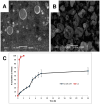Biopolymeric Inhalable Dry Powders for Pulmonary Drug Delivery
- PMID: 39770469
- PMCID: PMC11728674
- DOI: 10.3390/ph17121628
Biopolymeric Inhalable Dry Powders for Pulmonary Drug Delivery
Abstract
Natural and synthetic biopolymers are gaining popularity in the development of inhaled drug formulations. Their highly tunable properties and ability to sustain drug release allow for the incorporation of attributes not achieved in dry powder inhaler formulations composed only of micronized drugs, standard excipients, and/or carriers. There are multiple physiological barriers to the penetration of inhaled drugs to the epithelial surface, such as the periciliary layer mucus mesh, pulmonary macrophages, and inflammation and mucus compositional changes resulting from respiratory diseases. Biopolymers may facilitate transport to the epithelial surface despite such barriers. A variety of categories of biopolymers have been assessed for their potential in inhaled drug formulations throughout the research literature, ranging from natural biopolymers (e.g., chitosan, alginate, hyaluronic acid) to those synthesized in a laboratory setting (e.g., polycaprolactone, poly(lactic-co-glycolic acid)) with varying structures and compositions. To date, no biopolymers have been approved as a commercial dry powder inhaler product. However, advances may be possible in the treatment of respiratory diseases and infections upon further investigation and evaluation. Herein, this review will provide a thorough foundation of reported research utilizing biopolymers in dry powder inhaler formulations. Furthermore, insight and considerations for the future development of dry powder formulations will be proposed.
Keywords: biopolymers; dry powder inhalers; poly(lactic-co-glycolic acid); polycaprolactone; polysaccharides.
Conflict of interest statement
The authors declare no conflicts of interest.
Figures










Similar articles
-
Repurposing ebselen as an inhalable dry powder to treat respiratory tract infections.Eur J Pharm Biopharm. 2024 Feb;195:114170. doi: 10.1016/j.ejpb.2023.12.010. Epub 2023 Dec 19. Eur J Pharm Biopharm. 2024. PMID: 38128743
-
Dry powder inhalers in COPD, lung inflammation and pulmonary infections.Expert Opin Drug Deliv. 2015 Jun;12(6):947-62. doi: 10.1517/17425247.2015.977783. Epub 2014 Nov 12. Expert Opin Drug Deliv. 2015. PMID: 25388926 Review.
-
Development of an Inhaled Sustained Release Dry Powder Formulation of Salbutamol Sulphate, an Antiasthmatic Drug.Indian J Pharm Sci. 2016 Jan-Feb;78(1):136-42. doi: 10.4103/0250-474x.180261. Indian J Pharm Sci. 2016. PMID: 27168692 Free PMC article.
-
Building respirable powder architectures: utilizing polysaccharides for precise control of particle morphology for enhanced pulmonary drug delivery.Expert Opin Drug Deliv. 2024 Jun;21(6):945-963. doi: 10.1080/17425247.2024.2376702. Epub 2024 Jul 8. Expert Opin Drug Deliv. 2024. PMID: 38961522 Review.
-
Dry powder formulation of azithromycin for COVID-19 therapeutics.J Microencapsul. 2023 Jun;40(4):217-232. doi: 10.1080/02652048.2023.2175924. Epub 2023 Mar 27. J Microencapsul. 2023. PMID: 36752024
Cited by
-
Beta cyclodextrin stabilized cupric oxide nanoparticles assisted thermal therapy for lung tumor and its effective in vitro anticancer activity.Sci Rep. 2025 Aug 7;15(1):28983. doi: 10.1038/s41598-025-96578-3. Sci Rep. 2025. PMID: 40775400 Free PMC article.
References
-
- Hickey A.J., Thompson D.C. Physiology of the Airways. In: Hickey A.J., editor. Pharmaceutical Inhalation Aerosol Technology. Marcel Dekker, Inc.; New York, NY, USA: 2004. pp. 1–29.
Publication types
Grants and funding
LinkOut - more resources
Full Text Sources

